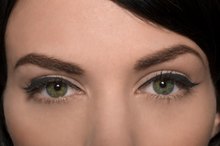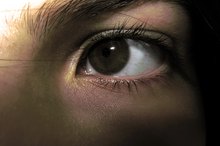The Effect of Cell Phone Radiation on Eyes
Your cell phone works by sending and receiving radio waves. Since they are a source of electromagnetic radiation that you hold close to your head, cell phones have been the subject of study by medical researchers concerned about effects on the eyes. The eyes are particularly vulnerable to heating effects from radio waves. However, while long-term detrimental effects may be possible, no clearly-defined risk for eyes has yet been established.
Radio Waves
Energetic forms of electromagnetic waves, such as ultraviolet (UV) light and X-rays, are what is called ionizing radiation. The waves have high energy, and even at low intensities can damage fragile biological molecules. Radio waves, such as those from your cell phone, have low energy and are non-ionizing. They can still affect your eyes, but they don’t cause molecular damage as ionizing radiation can.
- Energetic forms of electromagnetic waves, such as ultraviolet (UV) light and X-rays, are what is called ionizing radiation.
- Radio waves, such as those from your cell phone, have low energy and are non-ionizing.
Heating Effects
What are the Dangers of Infrared?
Learn More
When radio waves pass through biological tissue, they create a small amount of heat. A microwave oven cooks meat this way. It has a power level of about 1,000 watts and delivers all its energy into the food you’re cooking. Digital cell phones radiate under 3 watts of power, with a good fraction of this energy going through your body. Blood normally carries excess heat away from internal organs, but the eyes, having fewer vessels than other organs, are more vulnerable to heat.
- When radio waves pass through biological tissue, they create a small amount of heat.
- Digital cell phones radiate under 3 watts of power, with a good fraction of this energy going through your body.
Cataracts
According to a report by England’s National Radiological Protection Board, radio waves may cause cataracts through damage caused by the heating effect mentioned above 1. The amount of radio power involved is called the Specific Absorption Rate (SAR), which is measured in watts per kilogram of biological tissue. Reasonably, a large amount of power in a small amount of tissue will produce a large heating effect. Long-term exposure of rabbit’s eyes at a rate of 17 watts/kilogram (kg) produced no cataracts. The SAR from using a typical cell phone is about 1.6 watts/kg. Researchers needed power levels of 100 watts/kg before cataracts were produced.
Lesions
Solar Energy Health Effects on Humans
Learn More
The same National Radiological Protection Board report discusses tests done with pulsed radio waves 1. Instead of running continuously, these are brief bursts of radio energy. For tests running several hours at SAR levels of 2.6 watts/kg, medical researchers saw some bleeding from blood vessels in the eye.
- The same National Radiological Protection Board report discusses tests done with pulsed radio waves 1.
- For tests running several hours at SAR levels of 2.6 watts/kg, medical researchers saw some bleeding from blood vessels in the eye.
Cancer
A study reported in the January 2001 issue of Epidemiology reports an increased risk for uveal (intraocular) melanoma, a common type of eye cancer. However, no explanation was given as to how this might occur, and other studies have not been able to repeat these findings.
Related Articles
References
Writer Bio
Chicago native John Papiewski has a physics degree and has been writing since 1991. He has contributed to "Foresight Update," a nanotechnology newsletter from the Foresight Institute. He also contributed to the book, "Nanotechnology: Molecular Speculations on Global Abundance."









